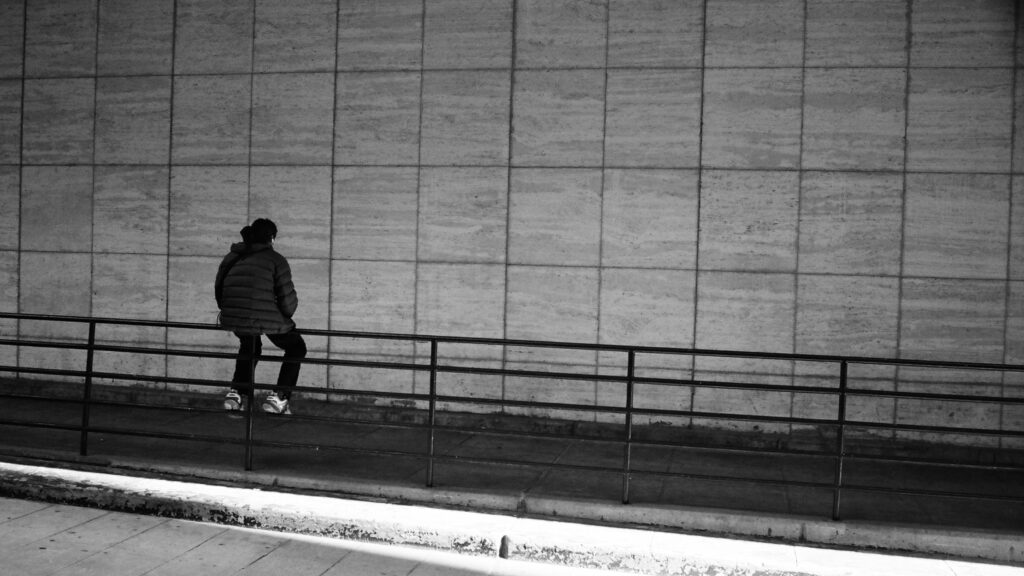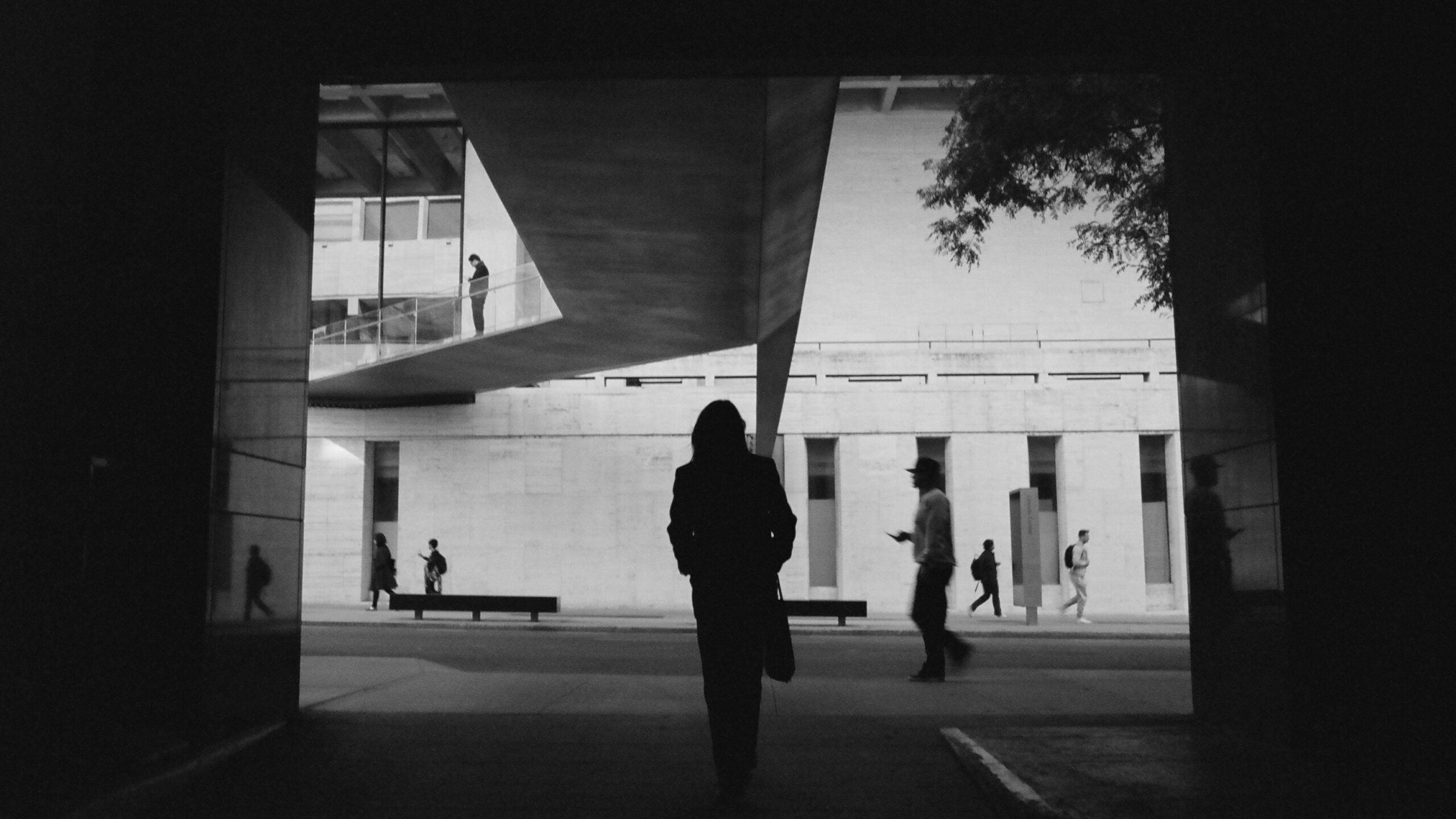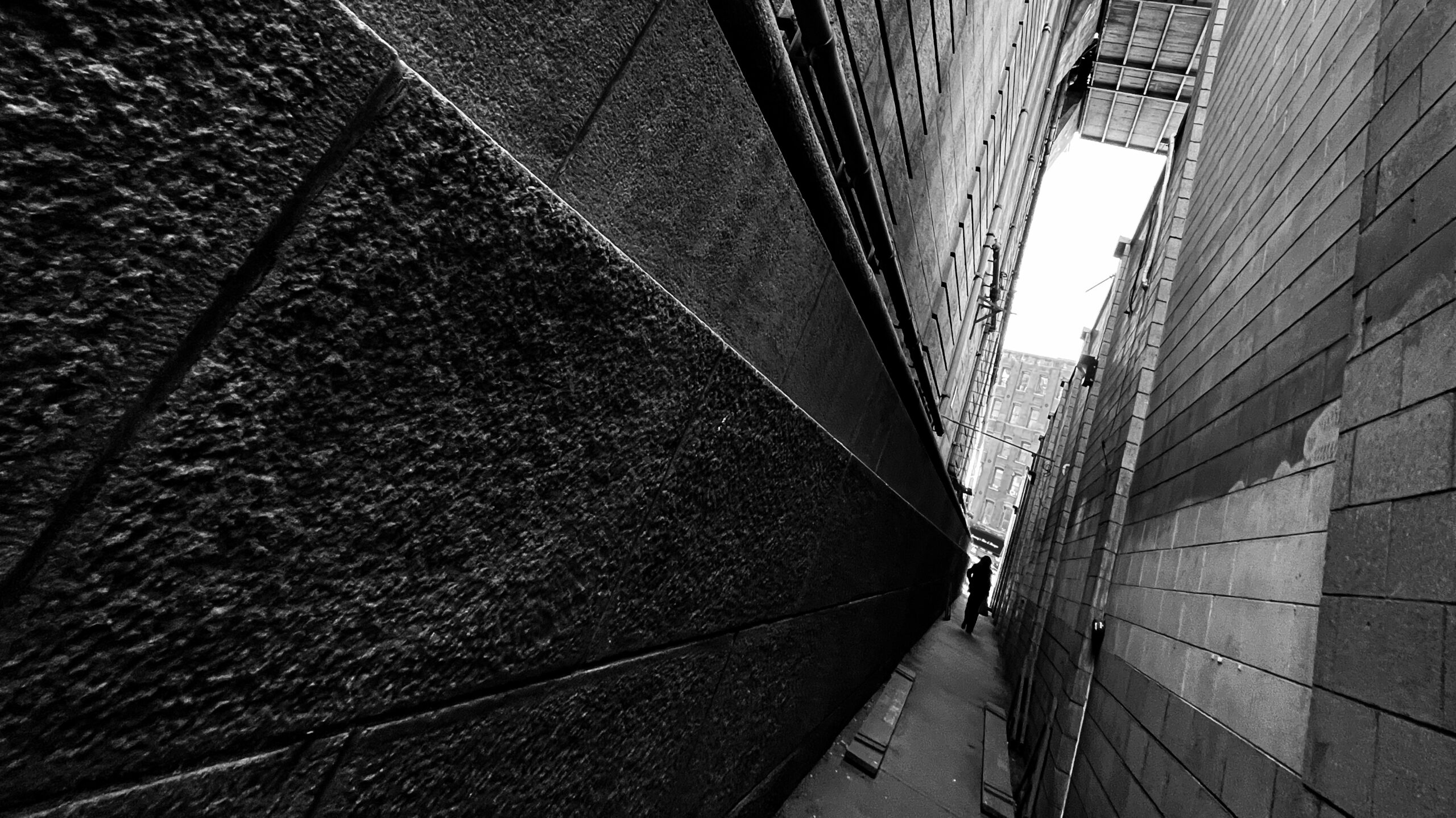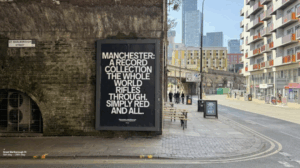Lingering in Transit: Xiang Zhang on Space, Silence, and Storytelling


Distant Depictions by Xiang Zhang presents a quiet study of distance: emotional, spatial, and cultural. Exhibited as part of the “Small Works” group show at Fox Yard Studio, the series consists of black and white photographs that linger in transitional spaces. With a background in film from the Beijing Film Academy and the London Film School, Zhang brings a cinematic sensibility to still images that resist narrative resolution, capturing scenes that feel suspended in time.
One photograph shows a solitary figure perched on a railing in front of a tiled wall, a moment that feels both incidental and deliberate. The space is flat and institutional, the subject passive, waiting or perhaps simply pausing. Another image captures a person walking down a narrow alley, the camera angled sharply as if the viewer is observing from a skewed perspective. The urban setting feels compressed, the human presence small, on the edge of being forgotten.

Though the work is quiet, it suggests deeper questions about visibility, place, and the structures we move through. Zhang’s use of framing and scale emphasizes the dominance of architecture over the individual. These visual choices imply a broader commentary on marginality and disconnection, particularly within global cities where movement often equates to erasure. The figures are not centered but instead exist within and against the spaces they occupy.
Zhang’s photographs do not seek to explain or resolve. Instead, they offer moments of ambiguity, encouraging the viewer to sit with what is withheld. The restraint is deliberate, and the atmosphere carefully constructed. With Distant Depictions, Zhang positions themselves as an artist attentive to the subtleties of dislocation, working within a visual language shaped as much by absence as by presence.
Your work spans experimental animation, narrative films, and fine art photography. How did your time at Beijing Film Academy and London Film School shape the evolution of your artistic vision?
From a young age, I have been deeply passionate about animation and film. This enthusiasm drove me to experiment early on with expressing my ideas through drawing. During high school, I received systematic and rigorous training in fine arts, which planted the idea of turning my passion into a profession. With this goal in mind, I applied to the Animation School of the Beijing Film Academy and was fortunate to be accepted.
At this multidisciplinary arts institution, the learning environment revolved around film while encompassing various artistic fields such as photography, painting, music, and even performance. Immersed in such an atmosphere, my fascination with visual storytelling grew significantly. However, at the time, my interest was largely driven by an appreciation for specific styles and a tendency to imitate them. It wasn’t until I joined the London Film School and underwent a more structured and professional filmmaking education that I began to realize an essential truth: drawing, photography, music, and writing are all structured artistic mediums. The key lies in how these mediums are used to tell stories and convey meaning.
Over the years, I have developed a creative process that has become second nature. Whenever I capture a compelling moment in life, I first document it with a camera. Then, I attempt to extend and explore it through drawing or writing, gradually distilling a core theme. Eventually, I bring it to life through moving images. The interplay of different mediums allows me to refine and reinforce my intended message while continuously providing new inspiration and creative momentum.
Transitioning from a character designer at West Mountain Game Company to a fine art photographer and videographer seems like a bold shift. What inspired this transition and how have those design skills informed your visual storytelling?
I initially chose to enter the gaming industry primarily for practical reasons. Compared to the animation or film industries, game companies generally offer higher salaries. With a solid foundation in drawing, I was able to find a place in this field, making it a viable means of livelihood at the time.
However, life cannot be sustained by practicality alone. The relentless demands of high-intensity, commercialized artwork left me mentally and physically exhausted. Over time, I came to realize that my true passion did not lie in this industry. This realization led me to pursue further studies, determined to follow my artistic aspirations.
That said, my experience in the gaming industry has greatly enriched my approach to visual storytelling. Character design in games emphasizes striking imagery, intricate details, and immersive atmospheres—elements that later became invaluable in my photography and filmmaking. It sharpened my sense of composition, deepened my understanding of light and shadow, and refined my ability to convey emotions through characters. These skills continue to add depth and dimension to my visual narratives.
How have the cultural environments of Beijing and London influenced your aesthetic choices and the themes you choose to explore?
Beijing is a city steeped in history and culture, yet over the past three decades, it has undergone a dramatic transformation through modernization. Skyscrapers have risen across the skyline, and beyond the Second Ring Road, traces of the city’s historical depth have become increasingly difficult to discern. Many view these towering structures as symbols of societal progress, but what often goes unnoticed is that, despite these external changes, people’s inner worlds have not experienced the same level of growth. Social divisions and class disparities remain as pronounced as ever.
This reality prompted deep reflection and became the foundation of my creative exploration. I began focusing on the absurdities that emerge amid rapid modernization, intertwining them with the everyday lives of ordinary people. Through this approach, I sought to create a sense of magical realism—one that encourages audiences to reflect on the underlying social issues. This theme not only shaped my work in Beijing but also extended to my explorations in other parts of China.
Moving to London further expanded my perspective. The city’s multicultural environment exposed me to new social issues, such as immigration and racial dynamics, while also introducing me to a diverse range of artists with distinct styles. Their influence pushed me beyond the relatively traditional aesthetic framework I had been accustomed to, encouraging me to experiment with more varied artistic expressions. This cultural shift not only broadened my artistic sensibilities but also made me more open and versatile in my creative pursuits, allowing me to engage with a wider range of artistic disciplines.

What specific challenges have you encountered in establishing yourself within the fine art community and how have you overcome them?
In China, one of the greatest challenges for an artist is the censorship system, which prevents me from creating with complete freedom. Even though my work does not directly engage with politics and instead focuses on issues of class and the survival of ordinary workers, it can still approach the boundaries of censorship, potentially impacting my career. In such an environment, creative freedom becomes especially precious, and these invisible restrictions often lead to artistic dilemmas and anxiety.
Even after moving to the UK, this struggle has not entirely disappeared. No matter where I am, my work remains deeply rooted in my cultural background, and I hope for it to be seen by ordinary people in China. However, this also means that I may still face potential restrictions in some form. In response to this challenge, I have chosen to connect with like-minded artists, supporting each other in exploring broader creative avenues. At the same time, I actively seek out new channels for screenings and exhibitions, striving to share my work on more overseas Chinese-language platforms. This allows my films and artistic expressions to reach a wider audience, ensuring that they remain visible despite the constraints.
What new directions or projects are you most excited to explore, and how do they align with your overall artistic journey?
I am currently fascinated by the application of AI in artistic creation and hope to integrate it into my creative process. AI has enabled me to quickly grasp knowledge from unfamiliar fields and merge it with my artistic practice, significantly enhancing efficiency. For instance, in filmmaking, music plays a crucial role in shaping atmosphere and emotion. In the past, this required the expertise of a professional composer, but now, I can simply input my ideas into an AI system and generate a foundational version almost instantly. While the initial result may not be perfect, through continuous refinement and guidance, I can eventually achieve the desired outcome.
Imagine the excitement of a future where an individual could single-handedly create an entire film! Of course, I understand the concerns that AI might dilute the uniqueness of artistic creation, but I don’t share this fear. While form and content may be replicable, the essence of artistic expression—the depth of thought and the creator’s insight—remains irreplaceable. True creativity stems from an artist’s understanding of the world and years of accumulated experience; AI is merely a tool that accelerates this process, but it cannot replace the soul of creation. I look forward to further exploring this intersection of AI and art, discovering new possibilities for their integration in the future.
The post Lingering in Transit: Xiang Zhang on Space, Silence, and Storytelling appeared first on Our Culture.





